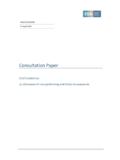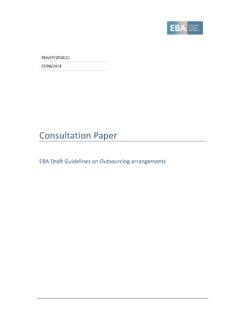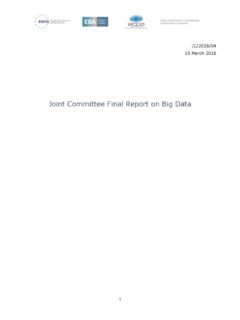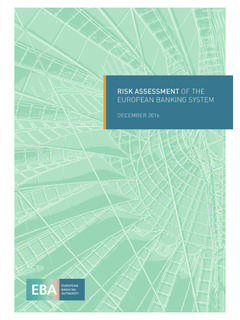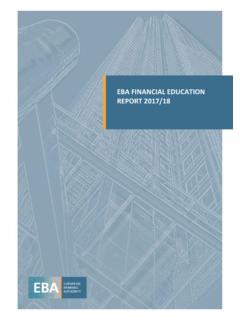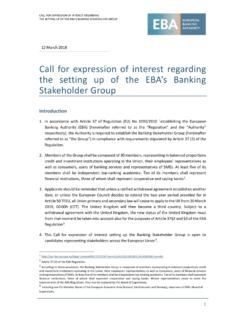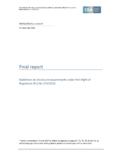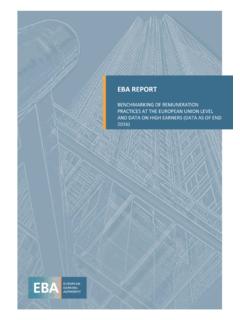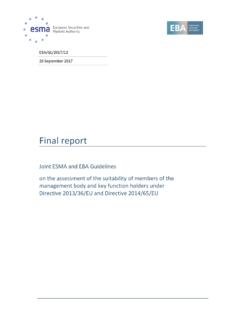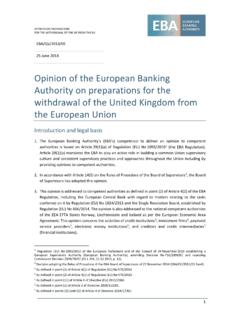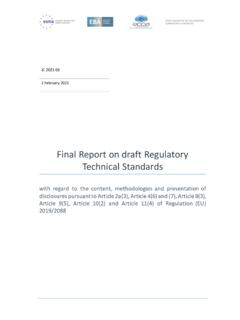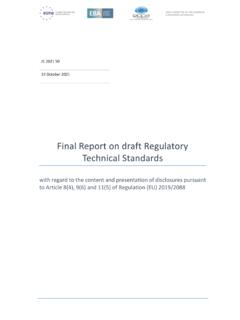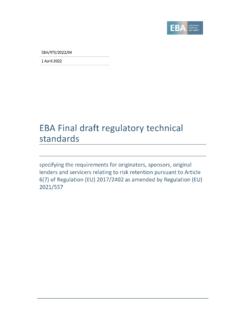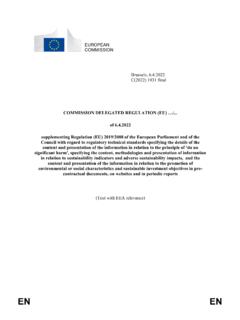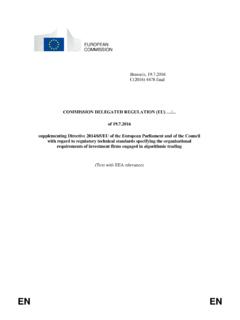Transcription of Final report - eba.europa.eu
1 EBA/RTS/2021/16 20 De ce mbe r 2021 Final report on draft regulatory technical standards under Article 9a (1) and (3) of Regulation (EU) No 1093/2010 setting up an AML/CFT central database and specifying the materiality of weaknesses, the type of information collected, the practical implementation of the information collection and the analysis and dissemination of the information contained therein F I NAL REPO RT O N DRAF T RTS UNDER ARTICLE 9A (1) AND (3) SETTING UP AN AML/CFT CENTRAL DATABASE 2 Contents Summary3 and rationale4 regulatry technical standards10 Cost-benefit analysis/impact assessment 37 Overview of questions for consultation45 Feedback on the public consultation46 F I NAL REPO RT O N DRAF T RTS UNDER ARTICLE 9A (1) AND (3) SETTING UP AN AML/CFT CENTRAL DATABASE 3 1.
2 Executive summary The EBA has a legal duty to contribute to preventing the use of the EU s financial system for money laundering and terrorist financing (ML/TF) purposes and to lead, coordinate and monitor the EU financial sector s fight against ML/TF. As part of this, Article 9 a(1) and (3) of the EBA Regulation confer on the EBA a mandate to establish and keep up to date a central anti-money laundering and countering the financing of terrorism (AML/CFT) database. In line with the legal mandate, the central AML/CFT database will contain information on material AML/CFT weaknesses in financial sector operators that competent authorities have identified.
3 It will also contain information on the measures competent authorities have taken in response to those material weaknesses. The draft regulatory technical standards (RTS) in this report specify when weaknesses are material, the type of information competent authorities have to report , how information will be collected and how the EBA will analyse and disseminate the information contained in the database. They also set out the rules necessary to ensure confidentiality, the protection of personal data and the effectiveness of the database.
4 The EBA will use this database to inform its view of ML/TF risks affecting the EU s financial sector. It will also share information from this database with competent authorities as appropriate, support them at all stages of the supervisory process and, in particular, if specific risks or trends emerge. This means that the database will act as an early warning tool that will help competent authorities to act before the ML/TF risk crystallise. As such, the AML/CFT central database will be key to strengthening AML/CFT supervision and in the coordination of efforts to prevent and counter ML/TF in the EU.
5 The EBA publicly consulted on these draft RTS between May and June 2021. Respondents welcomed the draft RTS. They said that the resulting database will contribute to a better system to fight ML/TF at the EU level and that it will facilitate the exchange of information between competent authorities, while achieving operational and cost efficiency. As part of the responses, some respondents requested that the EBA clarify further the definition of material weaknesses. Others highlighted the sensitive nature of the information the database will contain and asked that the draft RTS specify an applicable retention period for personal data.
6 The EBA has carefully considered all the responses and revised the RTS and the technical specifications where appropriate. Next steps The EBA will submit these draft RTS to the European Commission for approval. Once approved, the RTS will be directly applicable in all Member Repor t on dr aft RTS under Ar ticle 9a (1) and (3) setting up an AM L/CFT centr al database 4 2. Background and rationale 1. The EBA has a legal duty to contribute to preventing the use of the EU s financial system for ML/TF purposes and to lead, coordinate and monitor the EU financial sector s fight against ML/TF.
7 As part of this, Article 9 a(1) and (3) of the EBA Regulation confer on the EBA a mandate to establish and keep up to date a central anti-money laundering and countering the financing of terrorism (AML/CFT) database. 2. In line with the legal mandate, the central AML/CFT database will contain information on material AML/CFT weaknesses in financial sector operators that competent authorities have identified. It will also contain information on the measures competent authorities have taken in response to those material weaknesses.
8 The purpose is to bring together in one place the material weaknesses in financial sector operators identified by the competent authorities and the measures they have taken in response to inform the EBA s view of the ML/TF risks affecting the EU s financial sector. The EBA will use this database to inform its view of ML/TF risks affecting the EU s financial sector. It will also share information from this database with competent authorities as appropriate, support them at all stages of the supervisory process and, in particular, if specific risks or trends emerge.
9 This means that the database will act as an early warning tool that will help competent authorities to act before the ML/TF risk crystallis e. As such, the AML/CFT central database will be key to strengthening AML/CFT supervision and in the coordination of efforts to prevent and counter ML/TF in the EU. 3. Specifically, the EBA will use the central AML/CFT database to: a. share relevant information proactively on its own initiative with competent authorities in support of their supervisory activities on a risk-based approach; b.
10 Answer reasoned requests for information from competent authorities about financial sector operators to the extent that this information is relevant for competent authorities supervisory activities with regard to preventing the use of the financial system for the purpose of ML/TF; c. analyse information in the database on an aggregate basis to inform the Opinion on ML/TF risk and to perform risk assessments under Article 9 a(5) of the EBA Regulation; d. support the EBA s work to lead, coordinate and monitor the EU financial sector s AML/CFT efforts.
